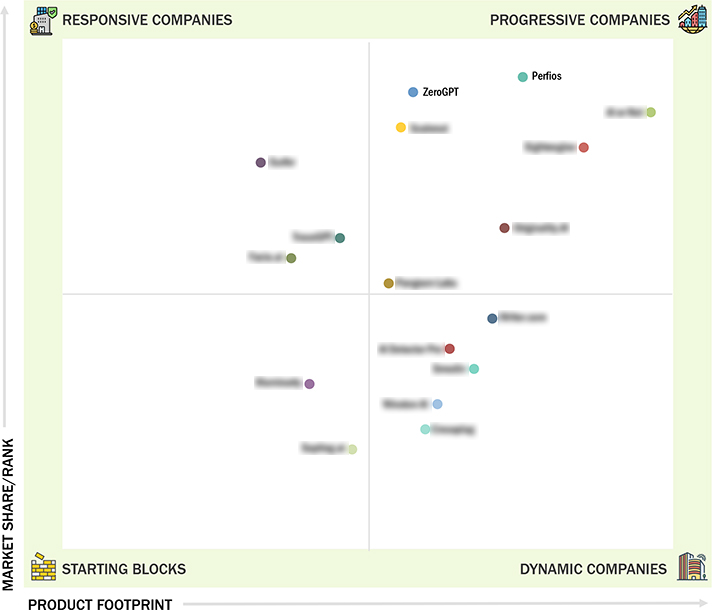Comparing 17 vendors in AI Detector Startups across 0 criteria.
The AI detector market encompasses software and platform capabilities crucial for identifying, scoring, and managing AI-generated or AI-manipulated content such as text, images, audio, and video in real-time. Initially focused on plagiarism detection, the market has matured, driven by the integration of machine learning and AI, which enhance detection accuracy in differentiating human-written from AI-generated content. Recent advances include the development of capabilities for detecting deepfakes and other AI-generated content, a necessity in high-risk digital landscapes . This rapid growth is driven by the increasing sophistication and accessibility of AI tools capable of generating synthetic media at scale. As a result, AI detectors are becoming indispensable in safeguarding digital ecosystems across various sectors, ensuring content integrity and credibility.
Key Market Drivers and Applications
Market Leadership Quadrant
1.1 Study Objectives
1.2 Market Definition and Scope
1.2.1 Inclusions and Exclusions
1.3 Market Scope
1.3.1 Market Segmentation
1.3.2 Years Considered
1.4 Currency Considered
1.5 Stakeholders
2.1 Introduction
2.2 Market Dynamics
2.2.1 Drivers
2.2.1.1 Cross-platform Content Dissemination Fueling Multi-format AI
Detection Adoption
2.2.1.2 Surge in Low-cost AI Generators Accelerating Demand for
Counter detection Tools
2.2.1.3 Brand Safety Mandates DrivingAI powered Ad Content
Verification
2.2.1.4 Advertiser-led Misinformation Control on Social Platforms
Boosting Detector Deployment
2.2.2 Restraints
2.2.2.1 High False Positive Rates Damaging Legitimate Creator Trust
2.2.2.2 Vulnerability to Paraphrasing and Homoglyph Attacks
2.2.3 Opportunities
2.2.3.1 Expansion into Real-time API Integrations for Chatbots and
Collaboration Tools
2.2.3.2 Radioactive Data Tracing for Enhanced AI Output Attribution
2.2.3.3 Integration with Blockchain-based Content Authenticity
Ledgers
2.2.4 Challenges
2.2.4.1 Limited Explainability of Content Flagging Decisions
2.2.4.2 Competitive Disadvantage of Small Vendors Against Rapidly
Advancing Big Tech AI Capabilities
2.3 Evolution of AI Detector Market
2.4 Supply Chain Analysis
2.5 Ecosystem Analysis
2.5.1 Text Detection Providers
2.5.2 Audio and Voice Detection Providers
2.5.3 Code Detection Providers
2.5.4 Image and Video Detection Providers
2.5.5 Multimodal Detection Providers
2.6 Investment Landscape and Funding Scenario
2.7 Technology Analysis
2.7.1 Key Technologies
2.7.1.1 Natural Language Processing (NLP)
2.7.1.2 Computer Vision
2.7.1.3 Machine Learning
2.7.1.4 Neural Text & Image Embeddings
2.7.1.5 Perplexity & Entropy Calculation Engines
2.7.1.6 Sequence Modeling
2.7.1.7 Audio Forensics
2.7.2 Complementary Technologies
2.7.2.1 Metadata Extraction & Forensics
2.7.2.2 Cloud Computing
2.7.2.3 Digital Watermarking
2.7.2.4 Data Labeling & Annotation Systems
2.7.2.5 Blockchain
2.7.3 Adjacent Technologies
2.7.3.1 Generative AI
2.7.3.2 Synthetic Media Generation
2.7.3.3 Plagiarism Detection Engines
2.7.3.4 Digital Identity Verification
2.7.3.5 Content Moderation Systems
2.8 Patent Analysis
2.8.1 Methodology
2.8.2 Patents Filed, By Document Type
2.8.3 Innovations and Patent Applications
2.9 Key Conferences and Events
2.10 Porter’s Five Forces Analysis
2.10.1 Threat of New Entrants
2.10.2 Threat of Substitutes
2.10.3 Bargaining Power of Suppliers
2.10.4 Bargaining Power of Buyers
2.10.5 Intensity of Competitive Rivalry
2.11 Trends/Disruptions Impacting Customers’ Businesses
2.11.1 Trends/Disruptions Impacting Customers’ Businesses
3.1 Overview
3.2 Key Player Strategies/Right to Win, 2022–2025
3.3 Market Share Analysis, 2024
3.3.1 Market Ranking Analysis
3.4 Product Comparative Analysis
3.4.1 Product Comparative Analysis, By AI Content Detector Provider
3.4.2 Product Comparative Analysis, By Deepfake Detection Provider
3.5 Company Evaluation Matrix: Other Players, 2024
3.5.1 Progressive Companies
3.5.2 Responsive Companies
3.5.3 Dynamic Companies
3.5.4 Starting Blocks
3.5.5 Competitive Benchmarking: Other Players, 2024
3.5.5.1 Detailed List of Other Players
3.5.5.2 Competitive Benchmarking of Other Players
3.6 Competitive Scenario
3.6.1 Product Launches and Enhancements
3.6.2 Deals
4.1 ZEROGPT
4.1.1 Business overview
4.1.2 Products/Solutions/Services offered
4.1.3 Recent developments
4.2 ORIGINALITY.AI
4.2.1 Business overview
4.2.2 Products/Solutions/Services offered
4.2.3 Recent developments
4.3 SIGHTENGINE
4.3.1 Business overview
4.3.2 Products/Solutions/Services offered
4.3.3 Recent developments
4.4 WRITER.COM
4.4.1 Business overview
4.4.2 Products/Solutions/Services offered
4.4.3 Recent developments
4.5 PERFIOS
4.5.1 Business overview
4.5.2 Products/Solutions/Services offered
4.5.3 Recent developments
4.6 AI OR NOT
4.6.1 Business overview
4.6.2 Products/Solutions/Services offered
4.6.3 Recent developments
4.7 AI DETECTOR PRO (AIDP)
4.7.1 Business overview
4.7.2 Products/Solutions/Services offered
4.7.3 Recent developments
4.8 SMODIN
4.8.1 Business overview
4.8.2 Products/Solutions/Services offered
4.8.3 Recent developments
4.9 SURFER
4.9.1 Business overview
4.9.2 Products/Solutions/Services offered
4.9.3 Recent developments
4.10 SCALENUT
4.10.1 Business overview
4.10.2 Products/Solutions/Services offered
4.10.3 Recent developments
4.11 WINSTON AI
4.11.1 Business overview
4.11.2 Products/Solutions/Services offered
4.11.3 Recent developments
4.12 ILLUMINARTY
4.12.1 Business overview
4.12.2 Products/Solutions/Services offered
4.12.3 Recent developments
4.13 CROSSPLAG
4.13.1 Business overview
4.13.2 Products/Solutions/Services offered
4.13.3 Recent developments
4.14 FACIA.AI
4.14.1 Business overview
4.14.2 Products/Solutions/Services offered
4.14.3 Recent developments
4.15 SAPLING.AI
4.15.1 Business overview
4.15.2 Products/Solutions/Services offered
4.15.3 Recent developments
4.16 PANGRAM LABS
4.16.1 Business overview
4.16.2 Products/Solutions/Services offered
4.16.3 Recent developments
4.17 TRACEGPT (PLAGIARISMCHECKER)
4.17.1 Business overview
4.17.2 Products/Solutions/Services offered
4.17.3 Recent developments


 einpresswire
einpresswire
 Nov 2025
Nov 2025

